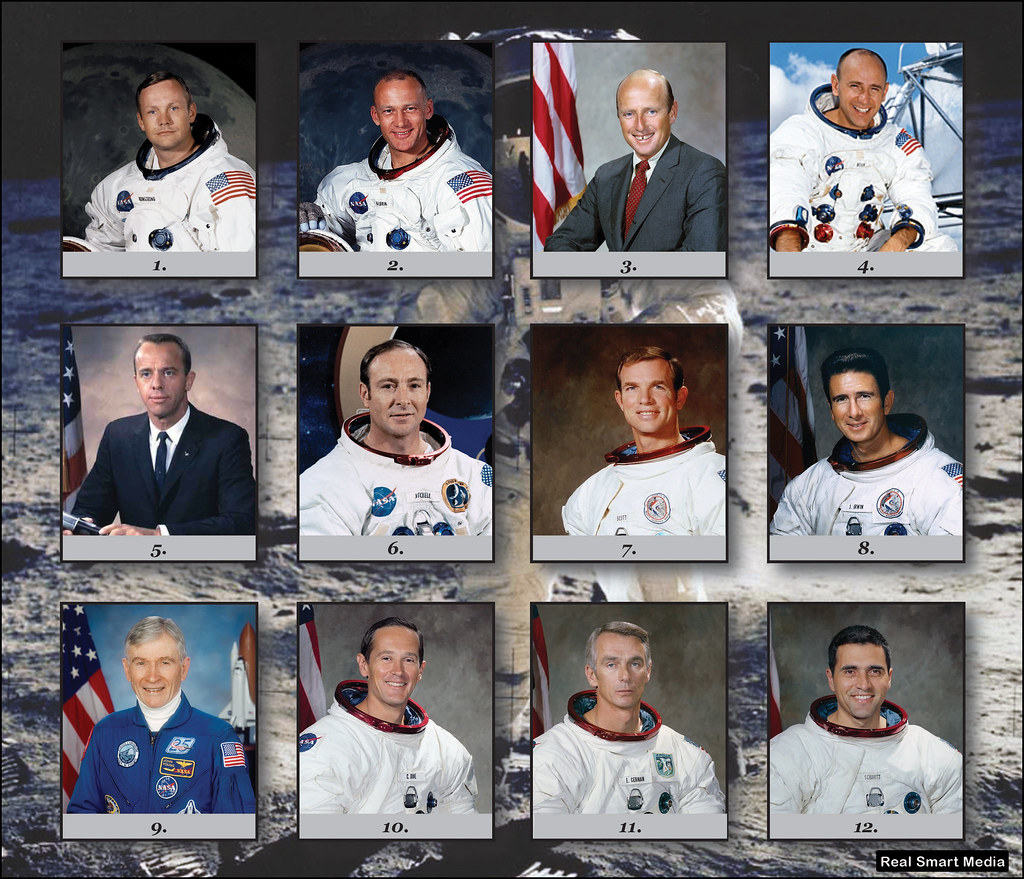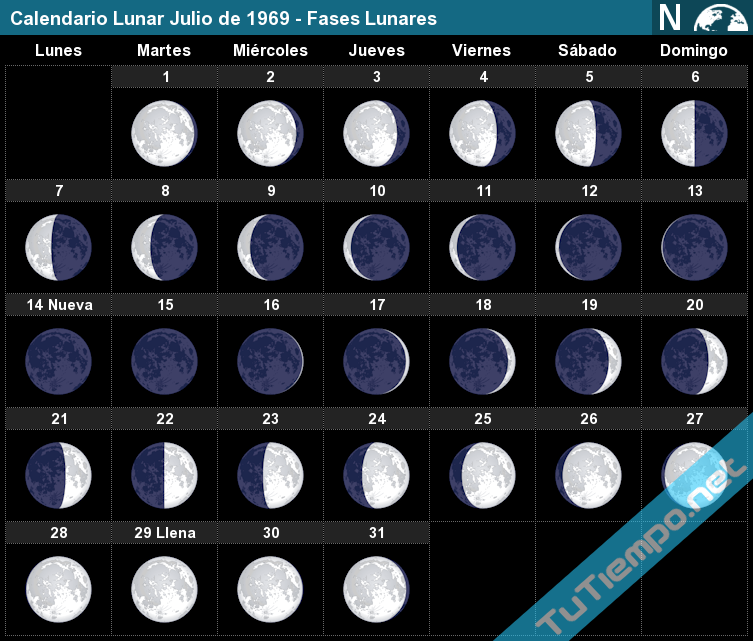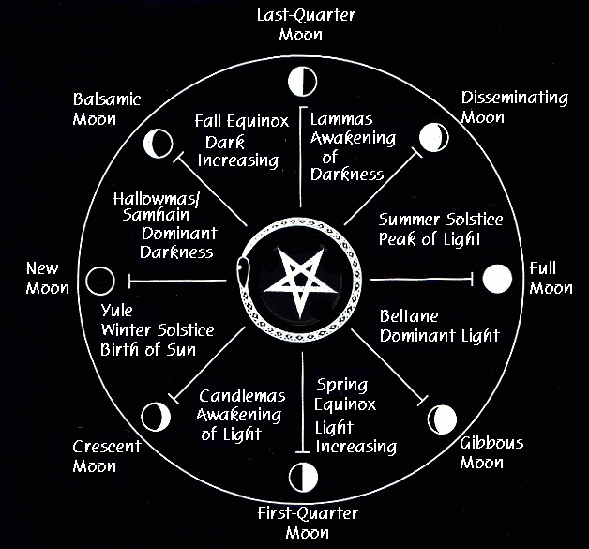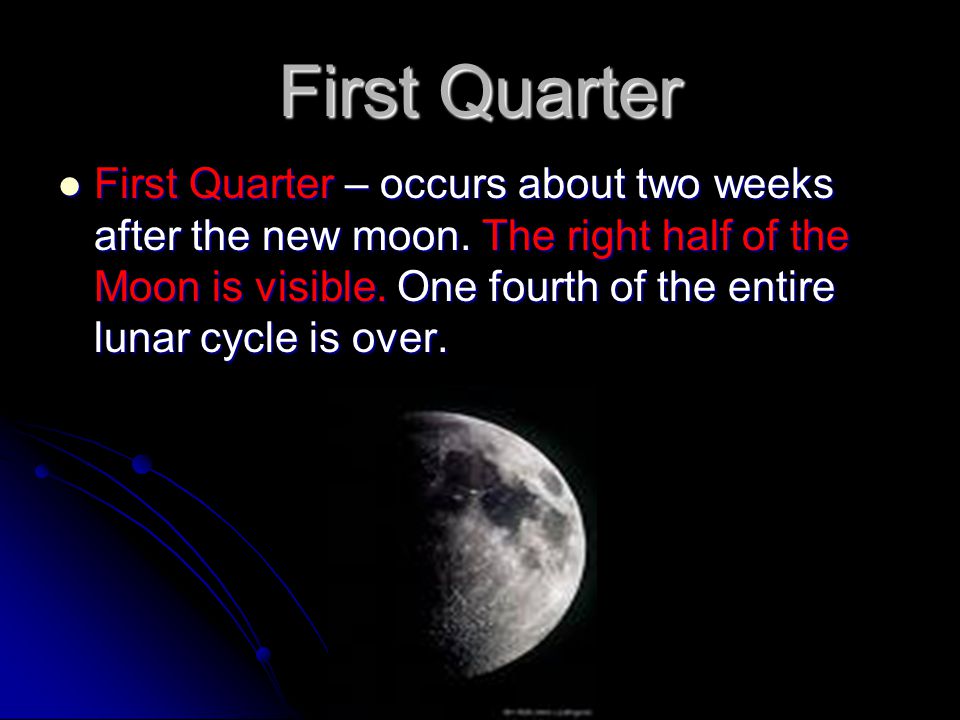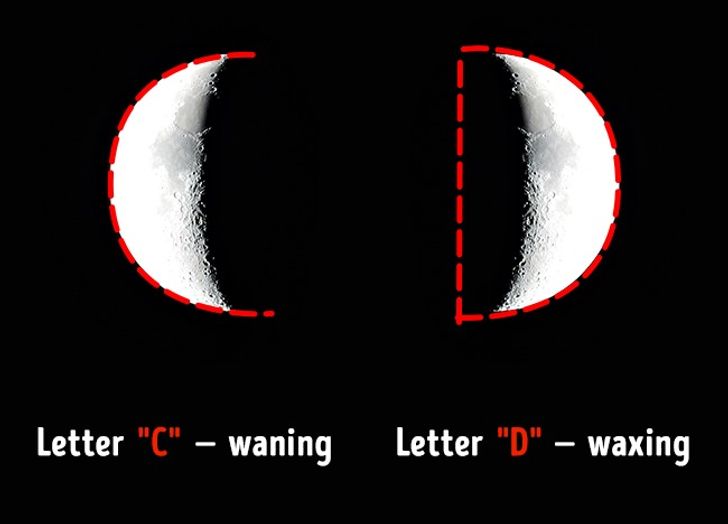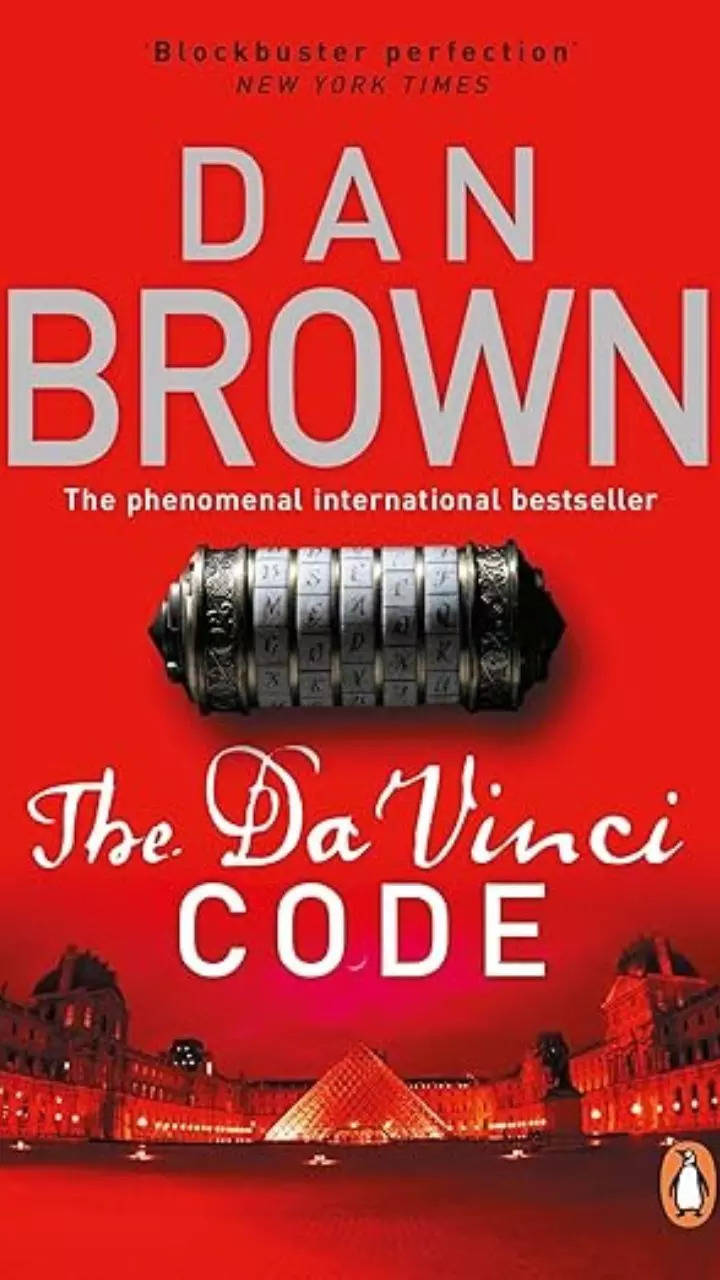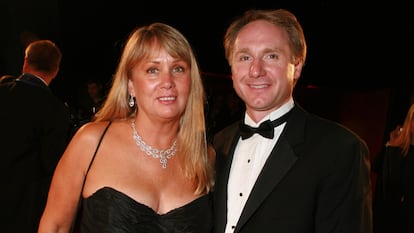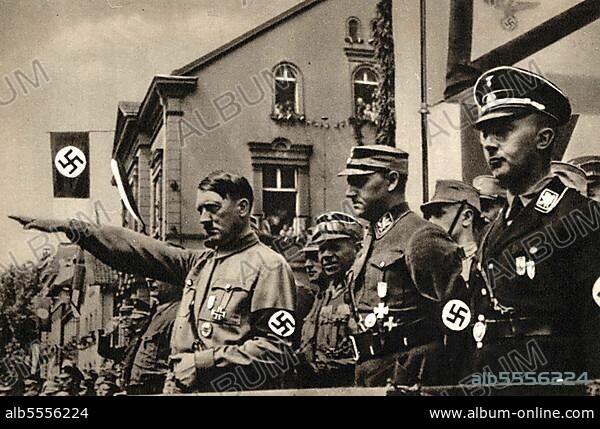|
|
General: WERNHER VON BRAUN, EL GENIO DETRAS DE LA PRIMERA LLEGADA A LA LUNA
Choose another message board |
|
Reply |
Message 1 of 102 on the subject |
|
|
|
|
|
Reply |
Message 88 of 102 on the subject |
|
|
|
|
Reply |
Message 89 of 102 on the subject |
|
Mary Magdalene is considered to be a saint by the Catholic, Eastern Orthodox, Anglican, and Lutheran denominations. In 2016, Pope Francis raised the level of liturgical memory on July 22 from memorial to feast, and for her to be referred to as the "Apostle of the apostles".
|
|
|
|
Reply |
Message 90 of 102 on the subject |
|
|
|
|
Reply |
Message 91 of 102 on the subject |
|
|
|
|
Reply |
Message 92 of 102 on the subject |
|
|
|
|
Reply |
Message 93 of 102 on the subject |
|
ESSAY HISTORYUSA January 11, 2019
V-2 and Saturn V: A Tale of Two Rockets
What does it mean that the same men who built a deadly rocket for the Nazis helped get America to the moon?
By Patrick HicksShareE-mail
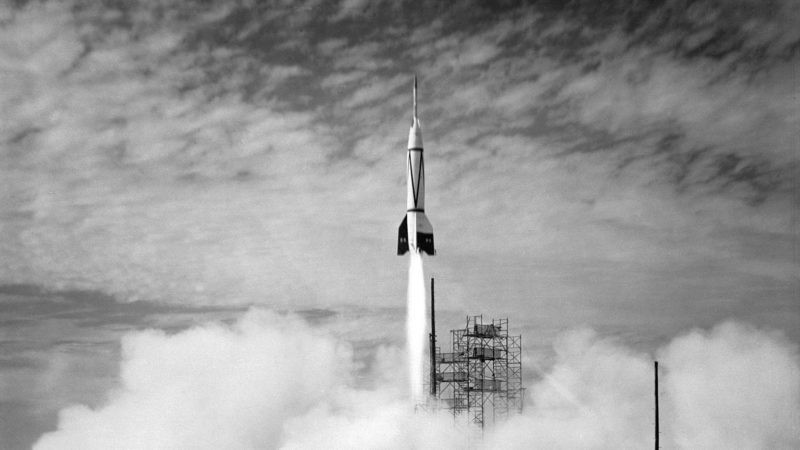
Bumper V-2 launch, July 1950. Photo: NASA. “The rocket will free man from his remaining chains, the chains of gravity which still tie him to this planet. It will open to him the gates of heaven.”
—Wernher von Braun
The world’s first functional long-range ballistic rocket, the V-2, weighed almost 28,000 pounds and could rumble fifty miles up into the crisp unexplored atmosphere. It was so technologically advanced that Nazi Germany became the first country to put an object made by human hands into space. During one particular test in the summer of 1944, launching from an island on the Baltic Coast called Greifswalder Oie, their rocket soared past the “Kármán Line”—which, in marking the boundary between our world and the black void beyond, puts the beginning of space at 100 kilometers above sea level, or roughly sixty-two miles straight up—by almost fifty miles. But the Nazis weren’t interested in setting altitude records. They only cared about height, so that the V-2 could arc over the top of a deadly parabola and then scream its way back down toward earth, where it would punch holes into cities hundreds of miles away. The V-2 was never designed to stay up in the heavens. It was designed to fall.
This Nazi rocket was essentially just an enormous projectile that didn’t require a cannon. A button was pushed, fuel ignited in blinding fury, and off it went into the clouds. The V stood for Vergeltungswaffe, or “vengeance weapon.” For its victims, it blew open the door to the next world. The V-2 was the brainchild of a young man named Wernher von Braun. Quick with a smile, he made parties sparkle with laughter and was known as something of a ladies’ man. Though only in his twenties, von Braun knew how to organize, how to charm, and—most importantly—how to turn blueprints into realities. He was the center of gravity for the V-2 program at Peenemünde: all major decisions orbited around him, and he made sure his rockets hit their intended targets. Von Braun joined the Nazi party in 1937, and three years later, Heinrich Himmler personally invited him to join the SS. Although von Braun accepted this commission, he would spend the rest of his life bending attention away from his involvement with the same organization that ran Dachau, Treblinka, and Auschwitz.
At first, Hitler was totally unimpressed with the V-2. He saw it as simply a massive artillery shell with an extremely long range. But as Germany began to lose the war, he slowly warmed to the idea. He wanted to punish the Allies by turning their pretty little cities into smoldering wastelands. On a July evening in 1943, von Braun dimmed the lights in an underground bunker and showed the Führer a silent movie of a V-2 taking off. As the film splashed life against a concrete reinforced wall, Hitler sat slumped in a wooden chair, a black cape draped over his shoulders. He watched as, in brilliant color, a rocket shot into the sky on a mute flame, then arced away at three times the speed of sound. Hitler beamed and jumped to his feet. He wanted to know what the “annihilating effect” of the warhead might be, and apologized that he hadn’t believed in the project sooner. Clapping his hands together, he made the young SS officer a professor on the spot. It was a rare honor. Within days, an order was given for thousands of V-2s to be built. The goal was to launch them like locusts towards New York and Washington, D.C. In time, maybe they could even reach Chicago.
After the war, when fame tapped him on the shoulder and he became the smiling face of America’s fledgling space program, von Braun made sure to downplay his involvement in the darker aspects of this effort. He talked instead about blueprints. He focused on gyroscopes, propellant, and lift. It wouldn’t be the last time he would obsess about such things, nor would it be the last time he would help make the impossible possible. In two short decades, von Braun would stand on the Florida coastline, part of another event that would shake the world’s understanding of reality.
*
After American and British bombers pulverized the existing plant at Peenemünde, German rocket assembly moved underground. Rather than rebuild a factory that could be hit again, the Nazis decided that everything should be hidden beneath a mountain. And so it was that they created a secret underground concentration camp. They marched skeletal prisoners into an old gypsum mine and ordered them to make it bigger. The prisoners plugged dynamite into rock, and blasted tunnels into a stubby mountain range called the Kohnstein. SS- Sturmbannführer Wernher von Braun visited the underground factory several times—he worked in an office just eleven miles away—and although he would later say the working conditions were “hellish” in the tunnels, he apparently had no qualms about using slave labor to advance his career. Few Nazis did.
The official name of the camp was Dora-Mittelbau, and it was built less than ten kilometers from the city of Nordhausen. Resting in the north of the Thuringia district, Nordhausen was graced with medieval architecture, a fine cathedral, and—before the war changed so many things—it was a proud city that had stood for over a thousand years. It was home to distilleries, breweries, and factories that made transportation equipment. At night, people gathered in restaurants to drink a popular beverage called korn, which is made from fermented rye. Swastika banners hung in the streets and the radio delivered good news about the future that Hitler was bringing to the nation. At first, the good news seemed unending: the annexation of the Sudetenland, the Anschluss of Austria, the conquest of Poland, and through it all, mighty England seemed powerless. And then the Führer truly outdid himself; he conquered France in less than two months. It seemed impossible. Something that years of bloody trench warfare had failed to accomplish between 1914 and 1918 had been achieved in just six short phases of the moon. After the invasion of the Soviet Union, however, the good news didn’t seem quite so frequent. If anything, the war seemed to be turning. Broadcasting from Berlin’s Sportpalast in February 1943, the Reich Minister of Propaganda, Dr. Joseph Goebbels, called for total war and promised that new “secret weapons” would soon be unleashed against the enemy.
Work began on the tunnels on August 28, 1943, when prisoners from the nearby concentration camp of Buchenwald were ordered to dig into a tough sedimentary rock known as anhydrite. It was so hard, in fact, that huge internal spaces wouldn’t need supporting beams. The Kohnstein was a natural fortress and it was obvious that American and British planes would never be able to bomb the assembly line of rockets hidden in its depths. Work on the tunnels accelerated, and by Christmas more than 10,000 prisoners were hammering and blasting their way into the Kohnstein. Deafening cracks of TNT sounded almost around the clock, dust particles filled up the prisoners’ lungs, and their blue-and-white striped uniforms were covered in fine powder.
The emaciated prisoners were ordered to clear away huge chunks of freshly dynamited rock. They tossed broken pieces into stubby rail cars known as grubenhunten. By sheer force of will, they muscled these carts down a track to a narrow-gauge locomotive, which pulled the stones out into the glare of the sun. These men—these expendable tools, these ghosts in waiting—were beaten if the grubenhunten were derailed or if they moved too slowly. There was no plumbing and the prisoners had to walk through streams of excrement. Not surprisingly, tuberculosis, typhoid, and pneumonia spread at fearsome rates. Withered men—husbands and fathers and sons—fell to the ground in unrelenting numbers. Still, the work continued.
To this day it’s unclear how many prisoners died building the tunnels, though the numbers are in the thousands. Their bodies were hauled away to Buchenwald, where they were burnt in a crematorium. As more prisoners were fed into the tunnels, the SS at Dora-Mittelbau requested their own oven for burning the dead; this wish was granted. Once the oven was fitted into place and fired to life, it didn’t take long before human ashes were tipped into a ravine that acted as a garbage dump.
By early 1944, both tunnels were finished, along with rail tracks that curved out from their gaping mouths. In all, some 35 million cubic feet of space had been gouged out of the Kohnstein to make way for the rocket assembly. Each tunnel was a mile long and two stories high. Think of Tunnel A and Tunnel B running parallel to each other with a gentle S curve to both. The two tunnels were linked by smaller tunnels. The world’s largest underground factory was finally ready for use, and the idea of the rocket was about to move from the realm of science fiction into the realm of science fact. What would soon roll out from this concentration camp would not only change the twentieth-century, it would rumble down the decades to come.
*
The V-2 had three different sections: the nosecone, which was packed with explosives and the navigation system; the center section, which held the propulsion system; and the engine, which had four tail fins around a nozzle to aid guidance and provide stability. The V-2s were assembled the same way that Henry Ford made his cars: each rocket moved down the tunnel and prisoners added parts as it inched for the exit. Near the end, the V-2s were painted olive green, laid down onto rail cars, and moved off to different locations across Germany. From there, maps were taken out. Coordinates were set. Countdowns began—five, four, three, two—and each rocket rumbled up into the blue. A column of smoke was all that remained as rocket after rocket curved for London, Brussels, Antwerp, and Paris.
But problems remained that prevented the V-2 from being mass-produced. In particular, Nazi scientists struggled with gyroscopes, turbo pump generators, and servomotors that moved the air vanes. These vanes proved especially tricky, because attempts at controlling something that was going several times the speed of sound were virtually unprecedented. How do you steer a bullet?
Although the missile could be launched from just about anywhere, the men in charge of these sleek messengers of death favored roads that ran through dense forests. After the rocket was placed on a mobile launcher known as a Meillerwagen, it could then be towed into a clearing, where it was propped upright and fired. Shortly after takeoff, the double-crack of a sonic boom could be heard for miles around. Bah-boom!
The V-2 entered English airspace at blistering speeds. No one knew it was coming.
And because the V-2 moved at nearly five times the speed of sound, air raid sirens all across London were suddenly useless. The rocket came straight down like a hammer. Upon impact, the warhead blasted a crater into the earth that was sometimes as wide as a bowling alley. Soil, brick, glass, and other debris fountained up. Moments later, ambulances and fire trucks whined awake. Smoke twisted up into the sky like a ghostly exclamation point. The rocket was no longer something of fantasy or the movies. It was now a weapon of mass murder.
*
A career soldier who had seen action in the Great War of 1914-1918, Walter Dornberger was a brilliant designer who held four patents in rocket development as well as an engineering degree from the Institute of Technology in Berlin. He was appointed to the Mittelbau Advisory Council in late 1943, where he thought up the mobile launch platforms that allowed individual V-2s to be moved around the countryside and therefore avoid detection from Allied bombers. After pacing the tunnels of Dora-Mittelbau himself, and being involved in crimes against humanity, Dornberger would go on to design high-performance aircraft for the United States. He would also play a significant role in the early development of the Space Shuttle. But before that, he and von Braun were honored at what had to have been one of the most unusual award ceremonies of the entire war.
It happened on December 9, 1944, at a place called Castle Varlar. This ancient monastery had been turned into a grand estate, and on this particular evening, the banquet hall was decorated with swastika flags, fine china, and silverware. Ivy was wrapped around a podium. A number of V-2s waited to be launched from the snowy gardens outside. Von Braun, Dornberger, and two other scientists were to be honored with the prestigious “Knight’s Cross,” and they wore tuxedos for the occasion. In between gourmet courses, the lights in the hall were shut off, a tall curtain at the end was pulled aside, and a V-2 was launched. Thunderous reverberations filled up the room as orange light from the exhaust flickered on the faces of the smiling men. The evening proceeded like this, alternating between food and firings.
Another important personality at Dora-Mittelbau was a man named Arthur Rudolph, who was in charge of production. Short and balding, he was von Braun’s right-hand man, making sure the V-2s were constructed properly and were rolling out of the tunnel at a steady clip. He didn’t care about prisoners dropping dead under his command; he only cared about quality control. He strolled through the tunnels to solve tricky engineering problems and, on at least one occasion, ordered production of the V-2s stopped so that all prisoners could watch a mass hanging. This was meant as a warning for anyone who might be thinking about sabotage.
As an enthusiastic Nazi, it was Rudolph’s job to make sure there was a constant supply of prisoners at Dora. His indifference to life is perhaps best exemplified by his reaction to being taken away from a lively New Year’s Eve party to solve a problem at the underground factory. With 1945 looming, a strap used to hold down the rockets wasn’t fitting properly. When he arrived at the tunnels, he realized there was nothing he could do until the morning. He didn’t notice the starving prisoners working around him at a fever pitch, nor did he care about the greasy black smoke that curled out of the crematorium. It’s possible that Arthur Rudolph stood outside Tunnel A on that evening, looked up at the moon, and wondered what the New Year would bring to him. Maybe, as he studied its bright celestial glow, he took long pulls from a bottle of champagne. A Chteau Lafite Rothschild, perhaps.
While we don’t know what Rudolph was thinking on that particular night, we do know that in the decades to come he, von Braun, and Dornberger would all become indispensable to America’s aerospace program. They would receive awards, honors, and ticker-tape parades. Their new country would welcome them. They would be showered with riches.
*
When the Americans discovered what was hidden at Dora-Mittelbau in April 1945, they packed up everything they could lay their hands on. Some 300 rail cars were loaded down with fuel tanks, fins, nosecones, servomotors, and engines. These pieces of the future were sent across the Atlantic to another secret camp: The White Sands Proving Grounds in New Mexico.
The V-2 was studied, examined, copied, and made better. On October 24, 1946, a camera was bolted to the side of the rocket and, as it roared up into the clear blue sky, snapped a photo every other second. It climbed to sixty-five miles (three miles above the Kármán Line) and took the very first photograph from space. The rocket tumbled back to Earth and smashed into the ground at a blazing 500 feet per second. Although the camera was destroyed, the film—encased in a heavy steel box—was not. The photo taken that day was grainy, yet the curvature of the earth can be seen clearly, along with a smudge of cloud. Scientists called it a “Rocket-Eye View” of the world. Nothing quite like it had ever been seen before.
The U.S. Army didn’t want the world to know about the technological wonders that had been found inside the mountain, so they kept the crimes against humanity that occurred at Dora classified. They believed the need for military secrecy was greater than the horrors that were committed. Propellant and sheet metal were given priority over blood and bone; certain numbers were given priority over others.
Design Specifications of the V-2:
Length: 45 feet, 11 inches
Diameter: 5 feet, 5 inches
Weight: 13.8 tons
Propellant: ethanol/water mixture and liquid oxygen Propellant Weight: 8,400 lbs.
Range: 200 miles
Peak altitude: 55 miles
Speed: 3,580 miles per hour Warhead: 2,200 lbs. of amatol
Number of Attacks:
1,696 on Belgium
1,403 on the United Kingdom 76 on France
19 on Holland
Number of Deaths due to V-2 Attacks:
5,500 (estimated)
Number of Deaths at Dora-Mittelbau:
20,000 (estimated)
Within months of World War II ending, a secret program called “Operation Paperclip” brought hundreds of Nazi administrators, chemists, and engineers to the United States. The numbers these men had locked in their heads were keys to new frontiers and new possibilities. And because their knowledge was in danger of falling into Russian hands, a blind eye was cast upon the crimes these gifted men may have committed. As they went about building jets and rockets and high-performance aircraft, any sticky questions were made to disappear. The dead were dead, the Cold War was turning hot, and it was a time for practicalities. America opened its arms to these men. They enjoyed barbecues and baseball. They tended gardens. They worked hard, and they got us to the moon.
The image Americans had of Wernher von Braun in the early days of the Space Race was that of an enthusiastic rocketeer, a genius. In a six-part series called Man in Space, which was made by Walt Disney and aired in 1955 on primetime television, cartoons about zero gravity appeared on the screen as von Braun cheerfully held up model rockets. He smiled and said that a space station could be built. It would be a floating city in the stars.
A few years later, von Braun launched America’s very first satellite. He made the cover of TIME magazine and was hailed as “America’s Missileman” for getting Explorer 1 up into the heavens. Von Braun’s problematic past with the SS and the Third Reich had been bleached clean. There was no mention of the tunnels, the V-2, or a ravine full of human ash at Dora-Mittelbau.
*
The Saturn V was monstrous. Colossal. It towered up thirty-six stories. And when it was filled with super-cooled fuel, it creaked and groaned like a living creature. It strained for ignition. What made the Saturn V particularly special was its engines. They were a masterwork of design. Thanks to an elaborate twisting and coiling of metal, liquid oxygen cooled the engine bells and kept them from melting; it acted like icy fingers moments before being funneled into the pathway of kerosene, also known as RP-1. In a thrust chamber, these two volatile gases flashed into an inferno. Thus, the fuel itself was used to cool the engine bells hundredths of seconds before it became flame. It was ice then fire, coolant then propellant, a dance of chemicals. Von Braun knew that a great deal of weight was needed to go to the moon, and his Saturn V lifted it all into the stratosphere in less time than it takes you to load the dishwasher.
See it. Hear it. Feel it.
That’s how people in the viewing area described what it was like to watch a Saturn V lift off. First, there was a silent scorching orange plume from the launch pad, which was quickly followed by mighty shockwaves that rippled across the swampy waters of the Kennedy Space Center. Birds fell dead from the sky. Crackling thunder filled the air. A moment later, reverberations hit people’s chests. Neckties vibrated. Quarters and dimes jingled in back pockets. Bracelets danced. And as the rocket continued to climb, it got louder and louder. People had to plug their ears.
Compared to that, the V-2 was little more than a bottle rocket.
*
Today, rusted out parts of V-2s are still buried in the tunnels of Dora-Mittelbau, and an entire Saturn V in pristine condition is on display at the Kennedy Space Center. Wernher von Braun was in charge of both. But who thinks of the Dora camp when stock footage of a Saturn V lifts off for the moon? As the letters U…S…A trail before the camera, who wants to be reminded that the ghostly blueprint of a Nazi V-2 lives in the genes of America’s most famous rocket?
As for Dora, little remains of the camp today. Few people come to walk the grounds or climb the low hill up to the crematorium. The chimney, however, once roared with fire. At night, hellish flames once spilled up to the stars and, as they did so, the plume must have looked like an inverted rocket, a V-2 turned upside down. The building rumbled with the fuel of flesh and bone.
The camp was torn down by the Soviets after the war, because they needed the barracks elsewhere to house the homeless. They blew up the tunnel entrances to keep adventure seekers out. In 1995, the German government dug into the Kohnstein so that visitors could see the underground factory deep beneath the mountain with their own eyes. Inside, it is dark, cold, and littered with rusty debris. Although the water table has risen and flooded several areas, it is still possible to see painted numbers on the walls. Several desks, smashed toilets, and engine nozzles can be seen in the cone of a flashlight. Everything is waste and rubble and twisted metal. At this very moment, rusting parts of V-2s are hiding in the dark.
Also at this very moment, there are undisturbed boot prints on the surface of the moon. They are up there, dusty, powdery, and bathed in perpetual sunlight. The American flag planted by Apollo 17, the very last mission to the moon, has been bleached white by the never-ending glare of the sun.
To some people, the Holocaust and walking on the moon both seem impossible. It is easier to trust that human beings are not capable of such raw evil and such brave ingenuity. These people use the word “hoax”. They create elaborate reasons to undermine reality. It is no accident that some want to believe the two most profound events of the twentieth century never happened.
But they did happen. They both happened.
Their stories are not only about shadow and sunlight, but about who we are, and what we might become. These rockets we made can lift us up, or carry the payload of our undoing.
|
|
|
|
Reply |
Message 94 of 102 on the subject |
|
|
|
|
Reply |
Message 95 of 102 on the subject |
|
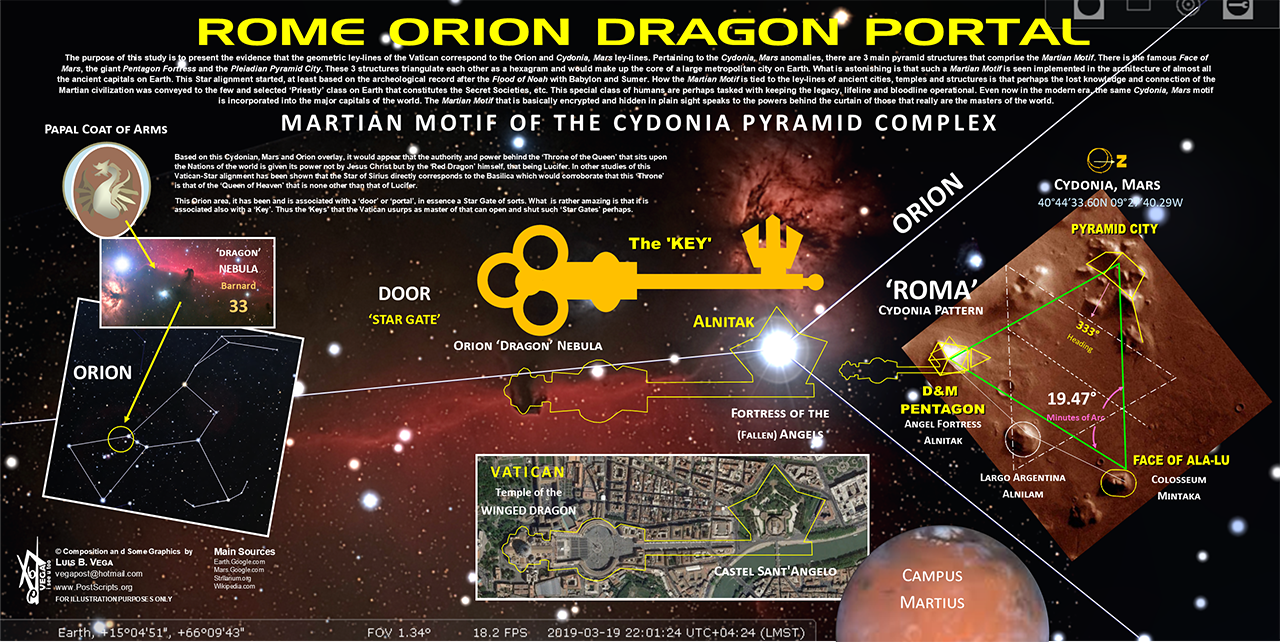
ANCIENT EGYPTIAN GEODESY - PART II
The great circle alignment from Giza to Alexandria has an azimuth of 51.85° north of due west from Giza (the same angle as the slope of the Great Pyramid). Extended beyond Alexandria, this great circle also crosses over Delphi, Rollright and Newgrange, as well as the city of London.
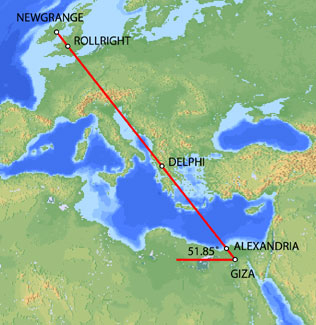
Map image © VectorGlobe
The azimuth of a great circle alignment from Dendera to Paris is also 51.85° north of due west.
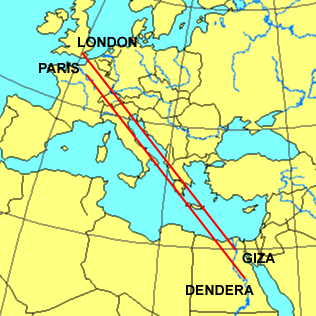
Map image - Roger Hedin
Dendera was dedicated to Isis/Sirius. The ancient Egyptian year began on the date of the heliacal rising of Sirius in mid July. The helical rising of Sirius heralded the annual inundation of the Nile that was essential to the welfare of ancient Egypt. The axis of the temple of Isis at Dendera was aligned 20° south of due east, pointing directly at the rising point of Sirius from the latitude of Dendera.
Robert Bauval describes a number of connections between Isis/Sirius and Paris in Talisman (2004). Isis is shown riding on a boat in many ancient Egyptian drawings and carvings. At the direction of Napoleon, Sirius and a statue of Isis were added to the coat of arms for Paris shown below.
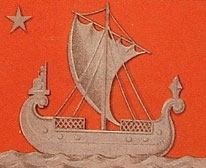
During the French revolution, a statue of Isis known as the Fountain of Regeneration was constructed on the former site of the Bastille. The engraving below commemorated this statue.
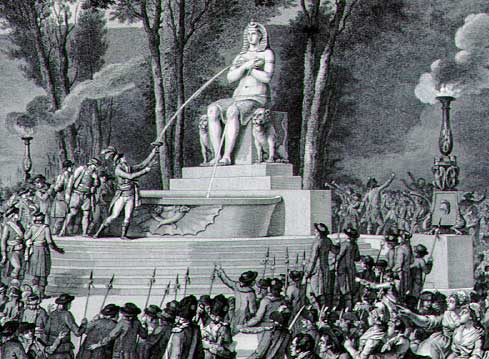
Fountain of Regeneration Engraving
The Elysian Fields is described as a place of eternal salvation in the ancient Egyptian Book of the Dead. Named after the Elysian Fields, the Champs Elysees is the main axis of Paris. The names Elysian and Elysees both suggest an association with Isis. The photograph below is facing southeast. The Arc de Triumphe is visible in the background. Beyond the Arc de Triumphe is the Louvre. The azimuth of the Champs Elysees is 26° south of due east, pointing directly at the rising point of Sirius/Isis from the latitude of Paris.
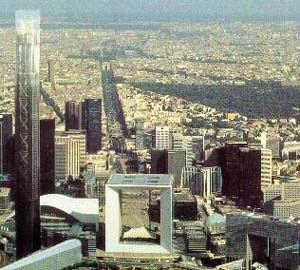
The termination point of the Champs Elysees to the northwest is the Grande Arche, in the foreground of the picture above. The axis of the Grande Arche is offset 6.33° south of the axis of the Champs Elysees. With an azimuth of just over 32° south of due east, the azimuth of the axis of the Grande Arche is the same as the azimuth of the great circle alignment from Paris to Dendera.
The Grande Arche is a nearly perfect cube with a height of 110 meters, a width of 108 meters and a depth of 112 meters. It is often described as a cube with side lengths of 110 meters. This is equal to 210 ancient Egyptian cubits:
110/210 = .5238
.5238 meters is a precise measure of the ancient Egyptian cubit, equating to 20.6222 inches, well within the ± .005 inches in Petrie's 20.62 inch measure of the ancient Egyptian cubit. Instead of the usual comparisons between the cubit and the meter of .52375/1 or .524/1, the best comparative measure may be the simple fraction of 11/21 that is suggested by the Grande Arche.
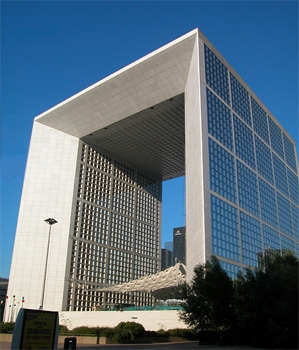
Image © Insecula.com
The sides of the Grande Arche are divided into 5 x 5 large panels and within each large panel are 7 x 7 smaller panels. Side lengths of 110 meters suggest lengths of 22 meters for the sides of the large panels with lengths of 22/7 meters for the sides of the smaller panels. The fraction 22/7 equals 3.1428, an accurate expression of π that is also found in the dimensions of the Great Pyramid. Side lengths of 210 cubits in the Grande Arche suggest lengths of 42 cubits for the sides of the large panels and 6 cubits for the sides of the smaller panels. This also shows that the relationship between the meter and the cubit is 6/π, using the measure of 22/7 for π:
21/11 = 6/π
22/7 x 21/11 = 6
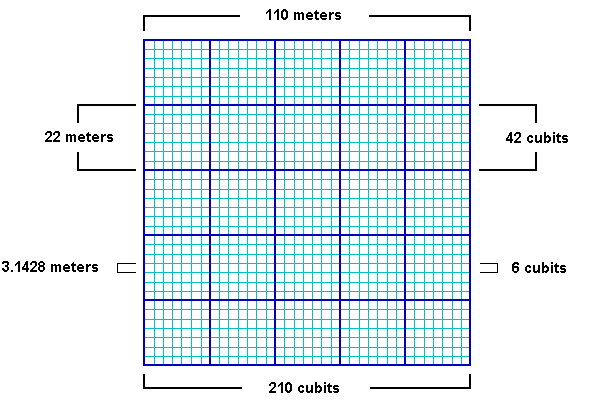
The northern pyramid at Dashur, known as the Red Pyramid, was the first true (smooth sided) pyramid built in Egypt and it was the last pyramid built prior to construction of the Great Pyramid. The baselengths of the Red Pyramid are 420 cubits (220 meters) long, 20x multiples of 21/11.
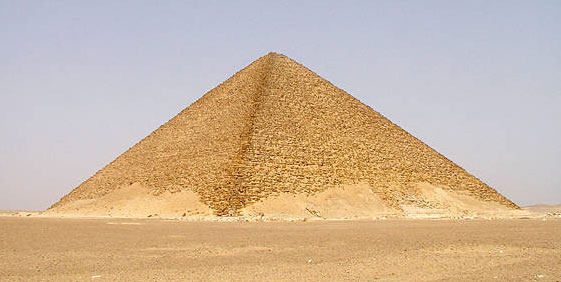
Image by Jon Bodsworth
One of the oldest stone circles in England is at Rollright. The diameter of the Rollright circle is 31.4 meters, an accurate expression of π times 10 meters. Given the 6/π relationship between the meter and the cubit, the diameter of the Rollright circle is also 60 ancient Egyptian cubits.

BACK
http://home.hiwaay.net/~jalison/Art5.html
|
|
|
|
Reply |
Message 96 of 102 on the subject |
|
  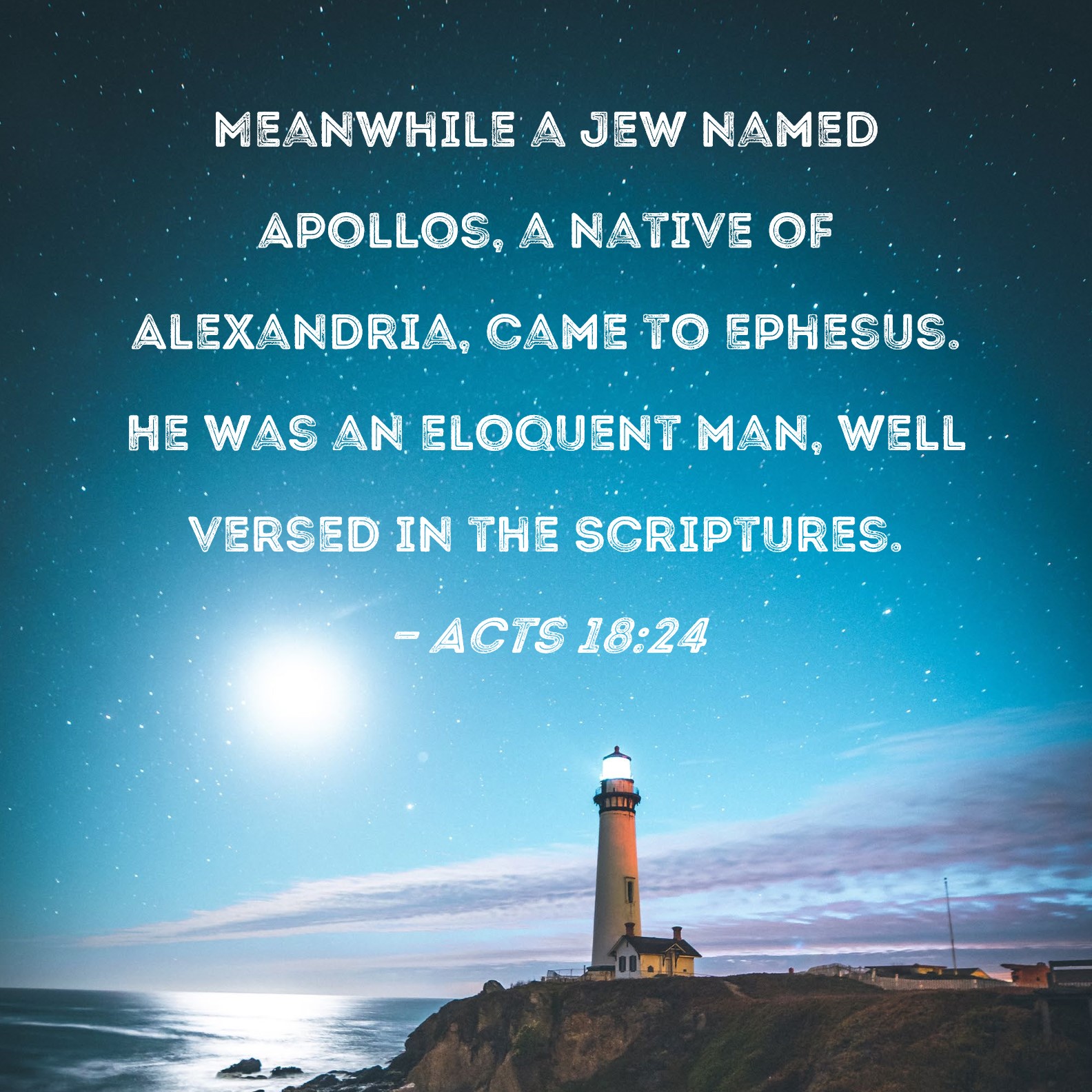 
New International VersionMeanwhile a Jew named Apollos, a native of Alexandria, came to Ephesus. He was a learned man, with a thorough knowledge of the Scriptures.
New Living TranslationMeanwhile, a Jew named Apollos, an eloquent speaker who knew the Scriptures well, had arrived in Ephesus from Alexandria in Egypt.
English Standard VersionNow a Jew named Apollos, a native of Alexandria, came to Ephesus. He was an eloquent man, competent in the Scriptures.
Berean Standard BibleMeanwhile a Jew named Apollos, a native of Alexandria, came to Ephesus. He was an eloquent man, well versed in the Scriptures.
Berean Literal BibleNow a certain Jew named Apollos, a native of Alexandria, came to Ephesus, being an eloquent man, mighty in the Scriptures.
King James BibleAnd a certain Jew named Apollos, born at Alexandria, an eloquent man, and mighty in the scriptures, came to Ephesus.
New King James VersionNow a certain Jew named Apollos, born at Alexandria, an eloquent man and mighty in the Scriptures, came to Ephesus.
New American Standard BibleNow a Jew named Apollos, an Alexandrian by birth, an eloquent man, came to Ephesus; and he was proficient in the Scriptures.
NASB 1995Now a Jew named Apollos, an Alexandrian by birth, an eloquent man, came to Ephesus; and he was mighty in the Scriptures.
NASB 1977Now a certain Jew named Apollos, an Alexandrian by birth, an eloquent man, came to Ephesus; and he was mighty in the Scriptures.
Legacy Standard BibleNow a Jew named Apollos, an Alexandrian by birth, an eloquent man, arrived at Ephesus; and he was mighty in the Scriptures.
Amplified BibleNow a Jew named Apollos, a native of Alexandria, came to Ephesus. He was an eloquent and cultured man, and well versed in the [Hebrew] Scriptures.
Christian Standard BibleNow a Jew named Apollos, a native Alexandrian, an eloquent man who was competent in the use of the Scriptures, arrived in Ephesus.
Holman Christian Standard BibleA Jew named Apollos, a native Alexandrian, an eloquent man who was powerful in the use of the Scriptures, arrived in Ephesus.
American Standard VersionNow a certain Jew named Apollos, an Alexandrian by race, an eloquent man, came to Ephesus; and he was mighty in the scriptures.
Contemporary English VersionA Jewish man named Apollos came to Ephesus. Apollos had been born in the city of Alexandria. He was a very good speaker and knew a lot about the Scriptures.
English Revised VersionNow a certain Jew named Apollos, an Alexandrian by race, a learned man, came to Ephesus; and he was mighty in the scriptures.
GOD'S WORD® TranslationA Jew named Apollos, who had been born in Alexandria, arrived in the city of Ephesus. He was an eloquent speaker and knew how to use the Scriptures in a powerful way.
Good News TranslationAt that time a Jew named Apollos, who had been born in Alexandria, came to Ephesus. He was an eloquent speaker and had a thorough knowledge of the Scriptures.
International Standard VersionMeanwhile, a Jew named Apollos arrived in Ephesus. He was a native of Alexandria, an eloquent man, and well versed in the Scriptures.
Majority Standard BibleMeanwhile a Jew named Apollos, a native of Alexandria, came to Ephesus. He was an eloquent man, well versed in the Scriptures.
NET BibleNow a Jew named Apollos, a native of Alexandria, arrived in Ephesus. He was an eloquent speaker, well-versed in the scriptures.
New Heart English BibleNow a certain Jew named Apollos, an Alexandrian by race, an eloquent man, came to Ephesus. He was mighty in the Scriptures.
Webster's Bible TranslationAnd a certain Jew named Apollos, born at Alexandria, an eloquent man, and mighty in the scriptures, came to Ephesus.
Weymouth New TestamentMeanwhile a Jew named Apollos came to Ephesus. He was a native of Alexandria, a man of great learning and well versed in the Scriptures.
World English BibleNow a certain Jew named Apollos, an Alexandrian by race, an eloquent man, came to Ephesus. He was mighty in the Scriptures.
Literal Translations
Literal Standard VersionAnd a certain Jew, Apollos by name, an Alexandrian by birth, a man of eloquence, being mighty in the Writings, came to Ephesus;
Berean Literal BibleNow a certain Jew named Apollos, a native of Alexandria, came to Ephesus, being an eloquent man, mighty in the Scriptures.
Young's Literal TranslationAnd a certain Jew, Apollos by name, an Alexandrian by birth, a man of eloquence, being mighty in the Writings, came to Ephesus,
Smith's Literal TranslationAnd a certain Jew, Apollos by name, an Alexandrian by birth, an eloquent man, arrived at Ephesus, being able in the writings.
Catholic Translations
Douay-Rheims BibleNow a certain Jew, named Apollo, born at Alexandria, an eloquent man, came to Ephesus, one mighty in the scriptures.
Catholic Public Domain VersionNow a certain Jew named Apollo, born at Alexandria, an eloquent man who was powerful with the Scriptures, arrived at Ephesus.
New American BibleA Jew named Apollos, a native of Alexandria, an eloquent speaker, arrived in Ephesus. He was an authority on the scriptures.
New Revised Standard VersionNow there came to Ephesus a Jew named Apollos, a native of Alexandria. He was an eloquent man, well-versed in the scriptures.
Translations from Aramaic
Lamsa BibleAnd a certain Jew named A-pol’los, a native of Al-ex-an’dri-a, an eloquent man and well versed in the scriptures, came to Eph'esus.
Aramaic Bible in Plain EnglishOne man, a Jew whose name was Apollo, a native of Alexandria and instructed in the word, was familiar with the Scriptures and he came to Ephesaus.
NT Translations
Anderson New TestamentAnd a certain Jew, named Apollos, an Alexandrian by birth, an eloquent man, and mighty in the Scriptures, came to Ephesus.
Godbey New TestamentAnd a certain Jew, Apollos by name, an Alexandrian by race, an eloquent man, came into Ephesus, being mighty in the scriptures.
Haweis New TestamentNow a certain Jew named Apollos, an Alexandrian by birth, a man of eloquence, who was powerful in the Scriptures, had come to Ephesus.
Mace New TestamentIn the mean time a Jew, nam'd Apollos, born at Alexandria, a man of letters, and vers'd in the scriptures, arriv'd at Ephesus.
Weymouth New TestamentMeanwhile a Jew named Apollos came to Ephesus. He was a native of Alexandria, a man of great learning and well versed in the Scriptures.
Worrell New TestamentNow a certain Jew, Apollos by name, an Alexandrian by birth, a learned man, came down to Ephesus; and he was mighty in the Scriptures.
Worsley New TestamentNow there came to Ephesus a certain Jew named Apollos, an Alexandrian by birth, an eloquent man, and mighty in the scriptures.
|
|
|
|
|
Reply |
Message 97 of 102 on the subject |
|
Adolf Hitler (* 20 April 1889 in Braunau am Inn) († 30 April 1945 Berlin), Leader of the Nazi Party, Reich Chancellor from 1933, also self-appointed "Fuehrer" and head of state of Germany.
https://www.album-online.com/detail/es/YTRkYWI0MA/adolf-hitler-april-1889-braunau-am-inn-1945-berlin-leader-alb5556224
EASTER SUNDAY
Mary Magdalene, seeing that the stone of the tomb had been rolled away, ran to tell Peter and John. After receiving the shocking news, the two disciples also went out and — as the Gospel says — “the two were running together” (Jn 20:4). The main figures of the Easter narratives all ran! On the one hand, “running” could express the concern that the Lord’s body had been taken away; but, on the other hand, the haste of Mary Magdalene, Peter and John expresses the desire, the yearning of the heart, the inner attitude of those who set out to search for Jesus. He, in fact, has risen from the dead and therefore is no longer in the tomb. We must look for him elsewhere.
This is the message of Easter: we must look for him elsewhere. Christ is risen, he is alive! He is no longer a prisoner of death, he is no longer wrapped in the shroud, and therefore we cannot confine him to a fairy tale, we cannot make him a hero of the ancient world, or think of him as a statue in a museum! On the contrary, we must look for him and this is why we cannot remain stationary. We must take action, set out to look for him: look for him in life, look for him in the faces of our brothers and sisters, look for him in everyday business, look for him everywhere except in the tomb.
We must look for him without ceasing. Because if he has risen from the dead, then he is present everywhere, he dwells among us, he hides himself and reveals himself even today in the sisters and brothers we meet along the way, in the most ordinary and unpredictable situations of our lives. He is alive and is with us always, shedding the tears of those who suffer and adding to the beauty of life through the small acts of love carried out by each of us.
For this reason, our Easter faith, which opens us to the encounter with the risen Lord and prepares us to welcome him into our lives, is anything but a complacent settling into some sort of “religious reassurance.” On the contrary, Easter spurs us to action, to run like Mary Magdalene and the disciples; it invites us to have eyes that can “see beyond,” to perceive Jesus, the one who lives, as the God who reveals himself and makes himself present even today, who speaks to us, goes before us, surprises us. Like Mary Magdalene, every day we can experience losing the Lord, but every day we can also run to look for him again, with the certainty that he will allow himself to be found and will fill us with the light of his resurrection.
Brothers and sisters, this is the greatest hope of our life: we can live this poor, fragile and wounded existence clinging to Christ, because he has conquered death, he conquers our darkness and he will conquer the shadows of the world, to make us live with him in joy, forever. This is the goal towards which we press on, as the Apostle Paul says, forgetting what lies behind and straining forward to what lies ahead (cf. Phil 3:12-14). Like Mary Magdalene, Peter and John, we hasten to meet Christ.
The Jubilee invites us to renew the gift of hope within us, to surrender our sufferings and our concerns to hope, to share it with those whom we meet along our journey and to entrust to hope the future of our lives and the destiny of the human family. And so we cannot settle for the fleeting things of this world or give in to sadness; we must run, filled with joy. Let us run towards Jesus, let us rediscover the inestimable grace of being his friends. Let us allow his Word of life and truth to shine in our life. As the great theologian Henri de Lubac said, “It should be enough to understand this: Christianity is Christ. No, truly, there is nothing else but this. In Christ we have everything” (Les responsabilités doctrinales des catholiques dans le monde d'aujourd'hui, Paris 2010, 276).
And this “everything” that is the risen Christ opens our life to hope. He is alive, he still wants to renew our life today. To him, conqueror of sin and death, we want to say:
“Lord, on this feast day we ask you for this gift: that we too may be made new, so as to experience this eternal newness. Cleanse us, O God, from the sad dust of habit, tiredness and indifference; give us the joy of waking every morning with wonder, with eyes ready to see the new colours of this morning, unique and unlike any other. […] Everything is new, Lord, and nothing is the same, nothing is old” (A. Zarri, Quasi una preghiera).
Sisters, brothers, in the wonder of the Easter faith, carrying in our hearts every expectation of peace and liberation, we can say: with You, O Lord, everything is new. With you, everything begins again.
https://www.vatican.va/content/francesco/en/homilies/2025/documents/20250420-omelia-pasqua.html |
|
|
 Primer Primer  Anterior 2 a 10 de 10 Siguiente Anterior 2 a 10 de 10 Siguiente  Último Último  |
|
|
|
|
Reply |
Message 98 of 102 on the subject |
|
|
|
|
Reply |
Message 99 of 102 on the subject |
|
|
|
|
Reply |
Message 100 of 102 on the subject |
|
|
|
|
Reply |
Message 101 of 102 on the subject |
|
|
|
|
Reply |
Message 102 of 102 on the subject |
|
|
|
 First First
 Previous
88 a 102 de 102
Next Previous
88 a 102 de 102
Next
 Last
Last

|
|
| |
|
|
©2025 - Gabitos - All rights reserved | |
|
|












